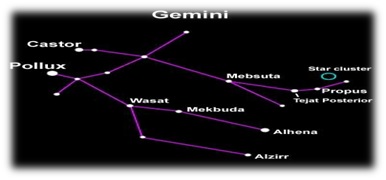
The constellation spotted many centuries ago typically show young twin boys seated close together. One can easily spot the northernmost constellation in the Zodiac. It is the constellation Gemini. Located in the northern hemisphere of the sky, Gemini was first catalogued by the Greek astronomer Ptolemy in the 2nd century. The name Gemini is derived from the Latin word meaning ‘twins’. Hence, the heads of its two brightest stars, Castor and Pollux are easily seen while the other stars make up faint outlines of the bodies. Let us discuss the details of this constellation further.
The constellation Gemini contains numerous stars, four of which have planets. The notable stars of the constellation are:
- Castor (Alpha Geminorum): Castor is basically the second brightest star in the constellation and is also the 44th brightest star in the sky. Also, it is a visual binary star with a combined magnitude of about 1.58. In Alpha Geminorum, each component is a spectroscopic binary star in itself, making it a four–star system. Approximately, the star is about 51 light years away from the sun.
- Pollux (Beta Geminorum): Pollux is the brightest star in the constellation and is the 17th brightest star in the night sky. It is an evolved orange giant having an apparent visual magnitude of 1.14. Pollux is approximately 33.78 light years away from the solar system. Beta Geminorum has a mass of about twice of that of the sun and is about nine times the solar radius.
- Alhena (Almesian) (Gamma Geminorum) - Gamma Geminorum is also a bright star in the constellation. It is easily visible to the naked eye as it has an apparent visual magnitude of about 1.915. It is approximately 109 years away from the earth. Gamma Geminorum is a white sub giant star.
- Mebsuta (Epsilon Geminorum): The outstretched right leg of Castor is the Epsilon Geminorum. It is a supergiant with an apparent magnitude of 3.06 and is about 840 light years away. Epsilon Geminorum is about 8,500 times brighter than the sun and also has 19 times the solar mass.
- Tejat Posterior (Mu Geminorum): In the constellation, Mu Geminorum is the fourth brightest star with a visual magnitude of 2.857 and is about 230 light years away. Mu Geminorum is also classified as a slow irregular variable.
- Tejat Prior (Eta Geminorum): Eta Geminorum is a multiple star which is approximately 350 light years away from the earth in the constellation. Eta Geminorum is a red giant, with its brightness ranging between the magnitudes of 3.15 and 3.9 respectively.
- Alzirr (Xi Geminorum): Xi Geminorum is a yellow–white sub giant star, about 11 times brighter than the sun. Xi Geminorum is 58.7 light years away from the earth and has an apparent visual magnitude of about 3.35.
- Wasat (Delta Geminorum): It is a yellow–white sub giant star that is bright enough to be visible to the naked eye. The visual magnitude of Delta Geminorum is 3.53 and it is about 60.5 light years away. It is also believed that Delta Geminorum is about 1.6 billion years old.
- Kappa Geminorum: In the constellation, Kappa Geminorum is a multiple star with a visual magnitude of 3.57 and is about 143 light years away from the solar system. Kappa Geminorum is also 78 times brighter than the sun.
- Lambda Geminorum: Lambda Geminorum is classified as a variable star, which has an apparent magnitude of 3.58 and is about 94.3 light years away. Lambda Geminorum is 28 times brighter than the sun and its age is estimated to be around 800 million years.
- Propus (Iota Geminorum): In the constellation, Iota Geminorum has an apparent magnitude of about 3.78 and is about 326 light years away. Iota Geminorum is also classified as a variable star.
- Mekbuda (Zeta Geminorum): The brightness of Zeta Geminorum in the constellation varies for a period of 10.148 days and its magnitude ranges from 3.68 to 4.16. It is also 2,900 times brighter than the sun.
- Tau Geminorum: Tau Geminorum is an orange giant with an apparent visual magnitude of 4.42 and is around 321 light years away from the solar system. Under good conditions, it is visible to the naked eye. It is also about 224 times brighter than the sun.
The other notable star in this constellation is U Geminorum.

Some of the deep sky objects of Gemini include:
- Messier 35 (NGC 2168): Messier 35 is basically an open star cluster, which covers a big area of the sky equivalent to the full moon. The visual magnitude of this cluster is about 5.30 and it is about 2,800 light years away from the earth.
- NGC 2158: It is an open cluster in the constellation which lies to the south–west of Messier 35. NGC 2158 has an apparent visual magnitude of about 8.6 and is about 11,000 light years away from the sun. NGC 2158 is believed to be a billion years old.
- Eskimo Nebula (NGC 2392): It is basically a bipolar double shell nebula. The star is surrounded by a layer of gas which is used to form the outer layers of a star similar to that of the sun. Eskimo Nebula has an apparent visual magnitude of 10.1 and is about 2,870 light years away from the solar system.
- Jellyfish Nebula (Sharpless 248): Jellyfish Nebula is a galactic supernova remnant in the constellation. It is situated near the bright star Eta Geminorum and is about 5,000 light years away from the earth.
- Medusa Nebula: Medusa Nebula is an old and large planetary nebula located near the border with Canis Minor. It has an apparent visual magnitude of 7.68 and is about 1,500 light years away from the solar system.
- Geminga: Geminga is basically a neutron star which is a decaying core of an old massive star that ended its life in a supernova explosion about 300,000 years ago. The apparent visual magnitude of Geminga is 25.5 and it is about 815 light years away from the sun.
- NGC 2129: It is a young, open cluster with a visual magnitude of 6.7 and is about 7,200 light years away from the sun. NGC 2129 is believed to about 10 million years old.
- NGC 2371–2: It is a planetary nebula which is dual lobed and has a visual magnitude of about 13. NGC 2371–2 is about 4,400 light years away from the earth. It is located to the south–west of the bright star Castor.
- NGC 2355: It is an open cluster made of old stars and is about a billion years old. It has visual magnitude of 9.7 and is about 5,400 light years away.
Gemini lies in the second quadrant of the northern hemisphere and is visible at latitudes between +900 and -600.
Gemini being a large constellation in the sky occupies an area of 514 square degrees.
According to the Greek mythology, when Zeus visited Queen of Leda of Sparta, wife of King Tyndareus, in the form of a swan, she became with both, the god and her mortal husband. Consequently, she gave birth to four children; Polydeuces and Helen were fathered by Zeus and were hence, immortal while Castor and Clytemnestra were the mortal children of Tyndareus. Castor and Polydeuces grew up inseparable and hence, when Castor was killed in a clash with another pair of brothers over two beautiful women, Polydeuces asked Zeus not to be separated from his brother. As a result, Zeus allowed the two to spend half of the time at Olympus and half in Hades. Also, they were given the power to save shipwrecked sailors by the sea god Poseidon and were hence, considered to be the patron saints of sailors.
Auriga, Cancer, Canis Minor, Lynx, Monoceros, Orion and Taurus are the neighboring constellations of Gemini.


